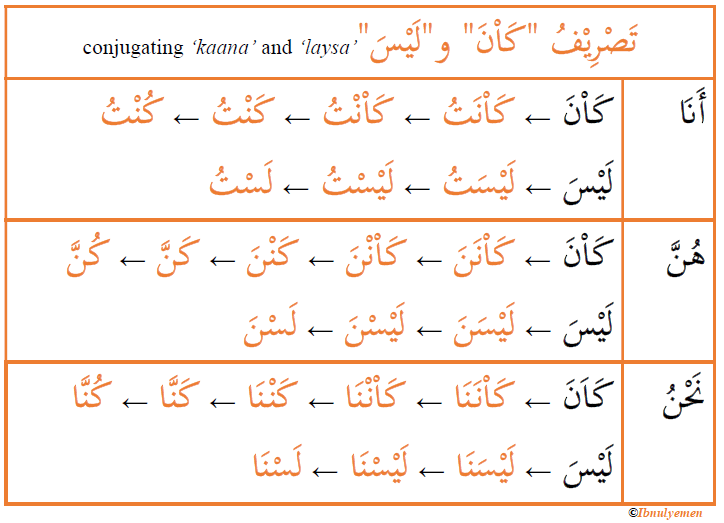Conjugating لَيْسَ laysa and كَاْنَ kaana Posted by Ibnulyemen اِبْنُ اليَمَن on Jul 27, 2017 in Grammar, Pronunciation, Vocabulary
The Arabic sentence is either اِسْمِيَّة ismiiyah ‘nominal’, i.e. has no verb, or فِعْلِيَّة fi‘liiyah ‘verbal’. Their frequency is similar. لَيْس laysa ‘not’ and كَانَ kaana ‘was/were’ are mainly associated with the nominal. Therefore, both are important and frequent; knowing the regularity and irregularity of their تَصْرِيْف taSriif ‘conjugation’ is essential for easier learning and effective use of Arabic.

لَيْسَ is for negation and كَاَنَ for past tense formation. As a rule, they are placed at the start of a sentence. In this case, their form remains the same except for gender agreement.
Examples:(*)
(1)
البَيْتُ كَبِيْر. al-bayt kabiir ‘the house is big.’
كَانَ البَيْتُ كَبِيْرًا. kaana al-bayt kabiiran ‘the house was big.’
لَيْسَ البَيْتُ كَبِيْرًا. laysa al-bayt kabiiran ‘the house is not big.’
(2)
البِنْتُ جَمِيْلَة. al-bint jamiilah ‘the girl is beautiful.’
كَانَت البِنْتُ جَمِيْلَةً. kaanat al-bint jamiilatan ‘the girl was beautiful.’
لَيْسَت البِنْتُ جَمِيْلَةً. laysat al-bint jamiilatan ‘the girl is not beautiful.’
(3)
الأَوْلادُ أَقْوِياء. al-awlaad aqwiiya’ ‘the boys are strong.’
كَانَ الأَوْلادُ أَقْوِيَاء. kaana al-awlaad aqwiiya’ ‘the boys were strong.’
لَيْسَ الأَوْلادُ أَقْوِيَاء. laysa al-awlaad aqwiiya’ ‘the boys are not strong.’
(4)
البَنَاتُ سَمِيْنَات. al-banaat samiinat ‘the girls are chubby.’
كَانَت البَنَات سَمِيْنَات. kaanat al-banaat samiinat ‘the girls were chubby.’
لَيْسَت البَنَات سَمِيْنَات. laysat al-banaat samiinat ‘the girls are not chubby.’
In (1) and (3), the forms of كَانَ and لَيْسَ are the same, i.e. not marked for gender or number even though the number in (1) is singular and plural in (3). This is always the case all verbs in the past tense forms when they precede the subject (i.e. doer); e.g., كَتَبَ الوَلَدُ kataba al-walad ‘the boy wrote’ and كَتَبَ الأَوْلَادُ kataba al-awlaad ‘the boys wrote’.
In (2) and (4), however, the forms of كَانَ and لَيْسَ are marked for gender with the ت (but not for number). In like manner, this applies to all past tense forms when they occur before the subject; e.g., كَتَبَتْ البِنْت katabat al-bint ‘the girl wrote’ and كَتَبَتْ البَنَات katabat al-banaat ‘the girls wrote’.
What if they (لَيْسَ and كَانَ) are placed after the subject, i.e. after the first word/phrase of the nominal sentence?
In this case, كَانَ and لَيْسَ must agree in gender and number. Let’s move them to second position, i.e. after مُبْتَدَأ mubtada’ ‘subject/topic’ in the above examples, and observe what happens.
(5)
البَيْتُ كَانَ كَبِيْرًا. al-bayt kaana kabiiran ‘the house was big.’
البَيْتُ لَيْسَ كَبِيْرًا. al-bayt laysa kabiiran ‘the house is not big.’
(6)
البِنْتُ كَانَت جَمِيْلَةً. al-bint kaanat jamiilatan ‘the girl was beautiful.’
البِنْتُ لَيْسَت جَمِيْلَةً. al-bint Laysat jamiilatan ‘the girl is not beautiful.’
(7)
الأَوْلادُ كَانُوا أَقْوِيَاء. al-awlaad kaanuu aqwiiya’ ‘the boys were strong.’
الأَوْلادُ لَيْسُوا أَقْوِيَاء. al-awlaad laysuu aqwiiya’ ‘the boys are not strong.’
(8)
البَنَات كُنَّ سَمِيْنَات. al-banaat kunna samiinat ‘the girls were chubby.’
البَنَات لَسْنَ سَمِيْنَات. al-banaat lasna samiinat ‘the girst are not chubby.’
In (5) and (6), there’s no number agreement as both are singular. But in (7) and (8), the number agreement is obvious. In (7), the plural marker ـوا is simply appended to the end of كَانَ and لَيْسَ. In (8), there is more to it than adding the number suffix. This is what matters most here. What is going on?
كَانَ has become كُنَّ. The weak letter of كَانَ has disappeared and the ن has become doubled. Here is the explanation: basically, the feminine plural suffix is نَ, i.e. ن with fatHah, so when appending it to كَانَ, it becomes كَانَنَ. As a rule, and for ease of pronunciation, the first ن loses it fatHah for a sukoon, and hence, كَانَنَ becomes كَانْنَ. Now you have two sukoon in a row كَاْنْنَ, one on ا and one on the ن. Grammatically, if you have two consecutive letters both with sukoon in the same word, the first letter should be dropped. Thus, we get كَنْنَ. Now, in كَنْنَ, you have two identical letters in a row, the first with a sukoon and the second with a fatHah. They qualify to become one with a shaddah, i.e. نَّ. How about كـَ? Why does it become كُـ? Great question! This is to disambiguate the meaning of كَاْنَ from the meaning of كَنَّ kanna ‘to remain quiet’—another word in Arabic.
Here is the sequence for conjugating لَيْسَ:
لَيْسَ ← لَيْسَنَ ← لَيْسْنَ ← لَسْنَ
In the table above you can see the serial conjugation of كَانَ and لَيْسَ with هُنَّ hunna ‘they(f)’, أَنَا ana ‘I’, and نَحْنُ naHnu ‘we’.
Exercise:
Try writing out the serial conjugation of كَاْنَ and لَيْسَ with these pronouns:
أَنْتَ أَنْتِ أَنْتُم هُم أَنْتُنَّ
Answers will be posted on Facebook Page after 24 hours.
NB: dual forms are not included because they are rather infrequent.

Build vocabulary, practice pronunciation, and more with Transparent Language Online. Available anytime, anywhere, on any device.




Comments:
Mathilde:
What about ” The house was not big” then ?
Thank you !
Ibnulyemen:
@Mathilde ahlan Mathilde,
given that ليس is used to negate nominal sentence in the present, to negate its past form, we have to first change it to the past, so البيت كبير (present) become كان البيت كبيرًا in the past “the house was big.” To negate a past tense sentence, we use the particles لم or ما. Using لم, it become لم يكن البيت كبيرًا “the house was not big” (note the form of كان changes to يكن due to the particle); however, if we use ما , nothing as far as the form changes so the sentence become ما كان البيت كبيرًا.
I hope this answers your question!
Mathilde:
@Ibnulyemen Thank you so much that was very clear ! l got it now 🙂